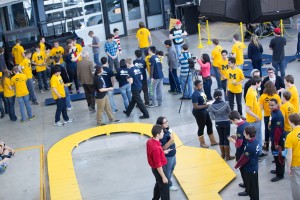

The racetrack used during University of Michigan-Dearborn’s annual Engineering/Computer Science Experience for high school students has seen better days.
The wood has warped over the years. And scratches and nicks reveal the half-dozen layers of paint used to keep it looking fresh.
College of Engineering and Computer Science (CECS) faculty Ghassan Kridli and Nattu Natarajan noticed the wear and tear. So did Alumni Affiliate Chair John Cole (’76 B.S.E.I.S.E).
That’s why Cole suggested reaching out to alumni or friends of the program to design a new track. Kridli, however, countered with a different idea: Students in his E100 course, Introduction to Engineering and Computers, could submit track prototypes as part of a semester-long design project.
Students were charged with designing a reconfigurable, portable track. The process was similar to what they would experience in a professional setting: They spent time learning the clients’ requirements, drawing preliminary designs, putting together prototypes, testing the designs and reconfiguring as needed.
“It’s neat to see the entire process, from the initial drawings to the final prototype,” said mechanical engineering student Teresa Campbell.
Kridli says that developing an appreciation for the engineering design process is especially important for students as they begin their engineering studies.
“We start them with projects in E100 so students know what to expect as they progress in their academic programs,” he said. “Nothing beats learning by doing. Through these projects, students gain a better understanding of solving design challenges and working with realistic constraints.”
That has been the case for electrical engineering student James Kua. The process—especially figuring out challenges like how to scale the full-size version to a smaller prototype—supplemented what Kua was learning in class.
“I liked the way the lab project was used as a way to show us how the design process was applied to real life,” he said. “It made these concepts easier to understand than when we first learned them in class.”
The campus community is invited to see the teams’ presentations Monday at 9:30 a.m. in the IAVS. There, judges may choose to select one design or a combination of elements from multiple designs. Kridli and Cole would like to see the new track constructed in time for the 2014 Engineering/Computer Science Experience.


